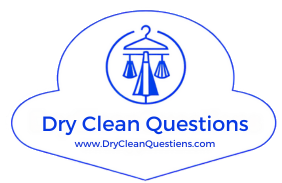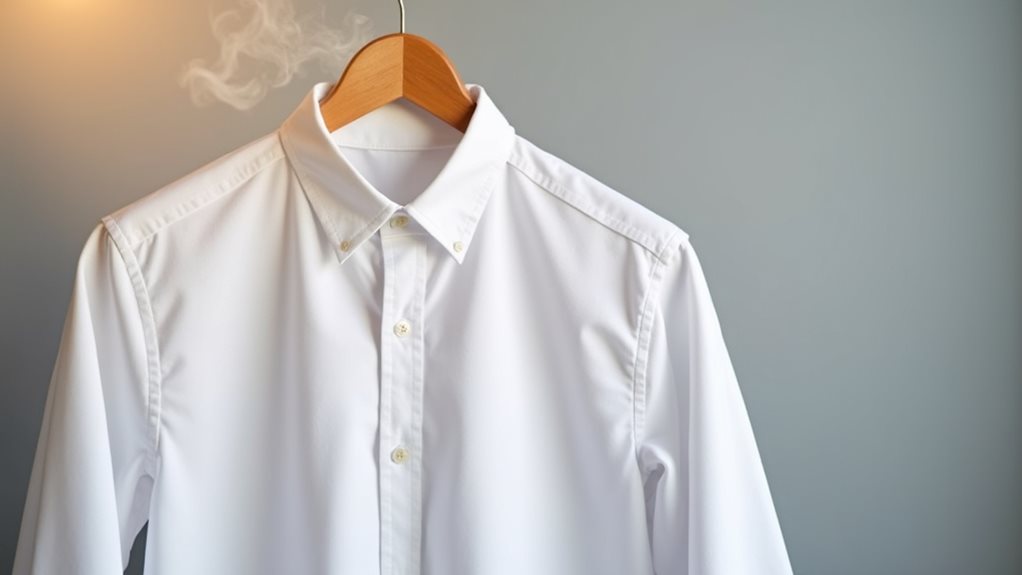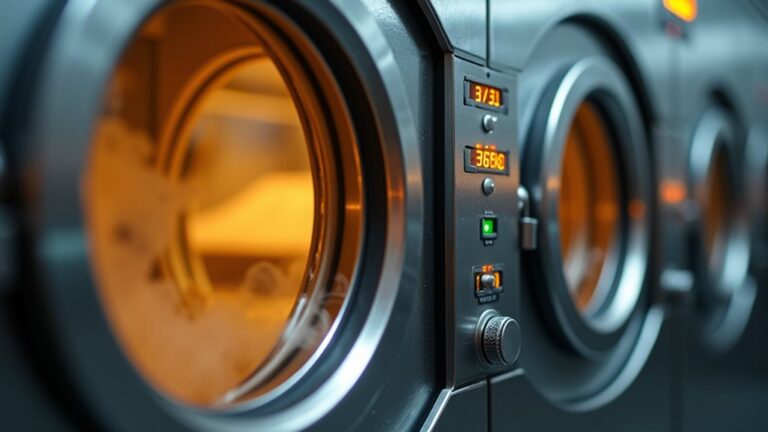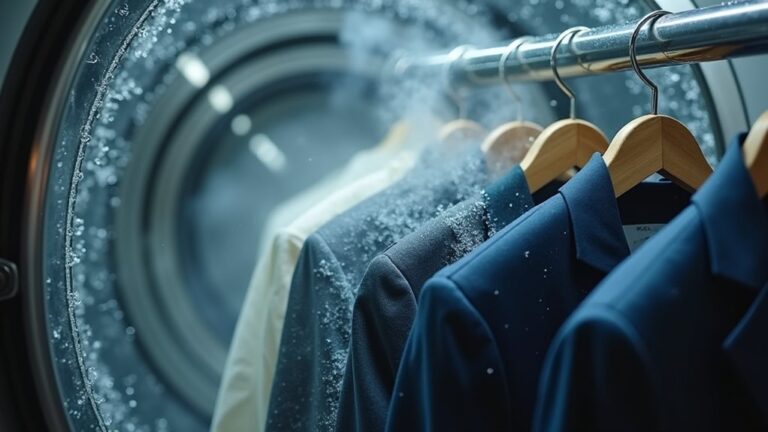Dry cleaning means your clothes get cleaned without water – instead, they’re treated with chemical solvents like perchloroethylene that dissolve stains and dirt from delicate fabrics. You’ll want this method for garments like wool suits, silk blouses, or anything labeled “dry clean only,” since water would damage these materials. The process involves pre-treating stains, running items through specialized machines with solvents, then pressing for that crisp finish you’ll discover more about below.
Definition and Basic Process of Dry Cleaning
The mystery of dry cleaning isn’t really mysterious at all—it’s simply a clever way to clean your clothes without using water, relying instead on chemical solvents like perchloroethylene (or “perc” as the pros call it) to lift away stains and dirt that would otherwise wreak havoc on delicate fabrics.
Dry cleaning uses chemical solvents instead of water to safely remove stains from delicate fabrics without causing damage.
When you drop off that silk blouse or wool sweater, the dry cleaning process begins with careful inspection, where experienced cleaners examine every inch and ask you about any stains you’ve noticed.
Next comes pre-spotting, followed by the actual cleaning in specialized dry cleaning machines that use cleaning solvents to gently remove stains without damaging your precious garments.
After the solvent cleaning, the garments go through a drying and pressing stage to restore their original appearance and ensure they look crisp and professionally finished when you pick them up. This process is particularly effective at removing oil-based stains that traditional water washing simply cannot eliminate.
It’s like giving your clothes a spa day!
Historical Development and Evolution

You’d be surprised to learn that dry cleaning isn’t some modern invention, but actually has roots stretching back to ancient Greece and Rome, where clever folks discovered they could clean their togas and tunics using powdered chemicals and absorbent clay instead of water.
The real breakthrough came much later though, when Thomas L. Jennings patented his “dry scouring” method in 1821, making history as the first African American patent holder while revolutionizing how we handle delicate fabrics.
From those early experiments with kerosene in 1825 Paris to today’s sophisticated solvents, the industry has constantly evolved to balance effective cleaning with safety concerns, showing us that sometimes the best solutions come from centuries of trial and error. 🧵
In 1855, Jean Baptiste Jolly accidentally discovered modern dry cleaning when his maid spilled kerosene onto a stained tablecloth, leading to the creation of the first dry cleaning business.
Ancient Cleaning Methods
Long before our modern dry cleaners existed with their whirring machines and chemical smells, ancient civilizations were already tackling the age-old problem of keeping clothes clean without water.
You’d be amazed to learn that Greeks and Romans mastered ancient cleaning methods using powdered chemicals and absorbent clay, creating surprisingly effective solutions for delicate fabrics.
These early innovators laid the groundwork for what would eventually become our modern dry cleaning industry, though they never imagined their techniques would evolve into today’s sophisticated dry cleaning service options.
While they didn’t have access to solvents like kerosene that came later, their clay-based approach proved remarkably successful at removing stains and revitalizing garments without the harsh effects of water washing.
The transition from these ancient methods to modern dry cleaning began in the mid-19th century when Jean Baptiste Jolly established the first commercial dry cleaning business in Paris around 1855.
Modern Solvent Development
While ancient civilizations accomplished remarkable feats with clay and powdered chemicals, the real breakthrough in dry cleaning came when Thomas L. Jennings patented his revolutionary “dry scouring” method in 1821.
You’d be amazed how this modern foundation transformed everything! By the 1930s, perchloroethylene became the industry standard because it actually worked without setting your clothes on fire, unlike earlier solvents that made cleaning shops resemble potential fire hazards.
William Joseph Stoddard’s 1924 development of safer alternatives marked another significant shift toward protecting workers and customers alike.
This chlorinated hydrocarbon proved particularly effective at dissolving oils, grease, and stubborn stains while being safely recyclable within the cleaning process itself.
Today’s environmentally friendly options, including liquid carbon dioxide and high-flashpoint hydrocarbons, represent the industry’s response to health concerns and regulatory frameworks like EU Regulation 2018/35, proving that innovation never stops evolving.
How Dry Cleaning Works Step-by-Step
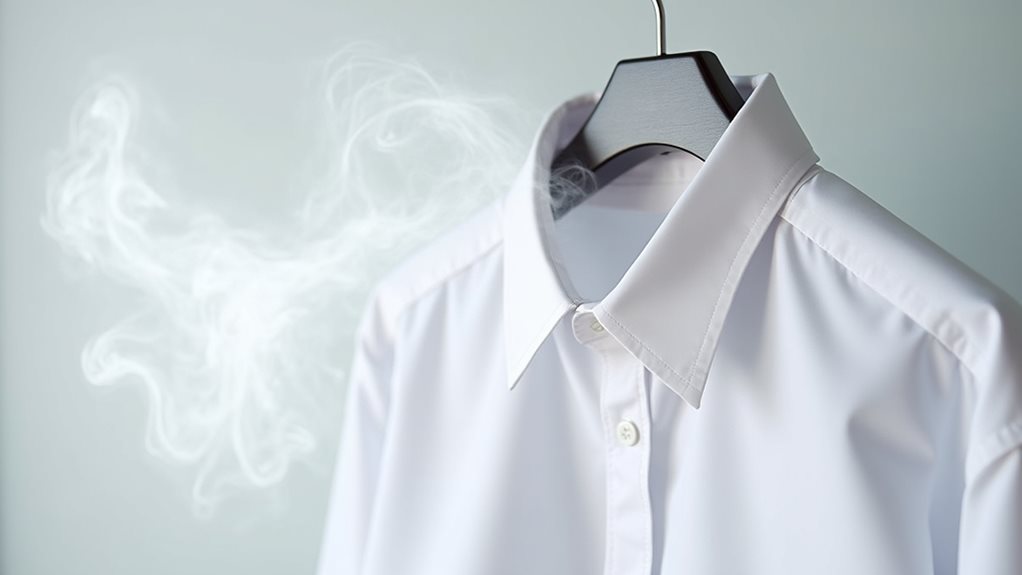
Understanding how dry cleaning works feels a bit like watching a carefully choreographed dance, where each step builds upon the last to transform your wrinkled, stained garments into crisp perfection.
The dry cleaning process starts when your clothes get tagged—think of it as giving each piece its own ID bracelet to prevent that awkward moment when someone else walks away with your favorite blazer 😅.
Next comes stain pre-treatment, where technicians become detectives, analyzing each spot and applying targeted chemicals.
Your garments then enter the cleaning machine, where a non-water-based solvent works its magic through gentle agitation.
The solvent extraction phase follows, where the cleaning solution is distilled and recycled for future use.
After a final inspection catches any stubborn stains, garment finishing transforms everything through careful pressing and steaming.
Solvents and Chemicals Used
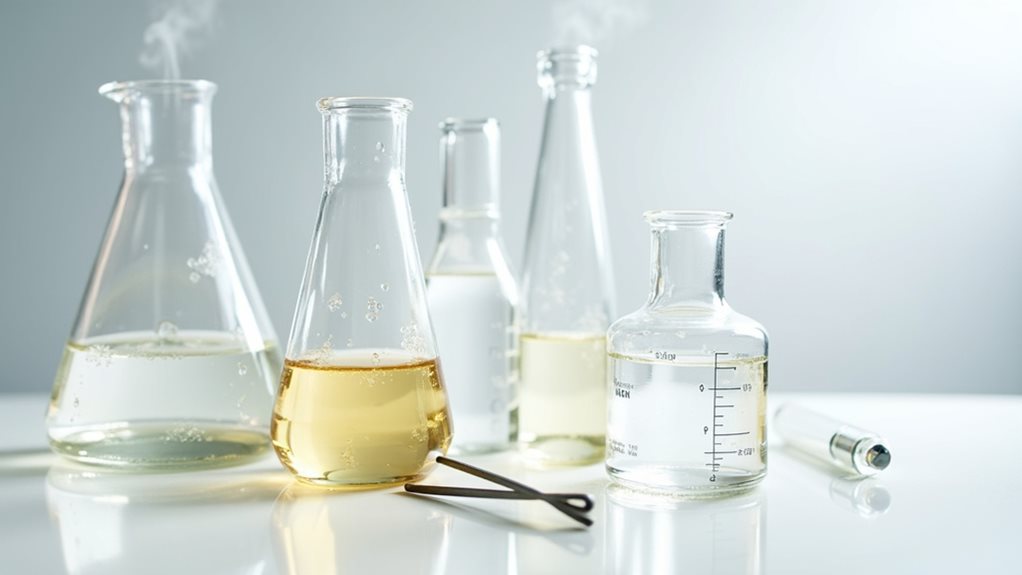
Behind the seemingly magical transformation of your stained clothes lies a carefully selected arsenal of chemical solvents, each one engineered to dissolve dirt and oils that water simply can’t touch.
The star player you’ll encounter most often is perchloroethylene (PCE), which has dominated dry cleaning for decades because it’s incredibly effective and won’t catch fire – though it’s classified as a volatile organic compound that raises environmental concerns.
Today’s industry is embracing alternative solvents with better environmental profiles, including high flash hydrocarbons and liquid carbon dioxide, as regulations tighten around traditional chemicals.
While older solvents like trichloroethylene have been largely phased out due to health risks, these newer options promise safer cleaning without compromising that crisp, professional finish you expect from your favorite dry cleaner.
Other petroleum components like petroleum spirits and Stoddard solvent have also been employed in dry cleaning operations, though with varying degrees of effectiveness and environmental considerations.
When to Choose Dry Cleaning Over Water-Based Methods

Now that you know which powerful solvents are working their magic behind the scenes, the real question becomes knowing when your favorite garments actually need this specialized treatment versus a simple trip through your washing machine.
You’ll want to choose dry cleaning for delicate fabrics like silk, wool, and cashmere that water might damage or distort. Those “dry clean only” labels aren’t just suggestions – they’re your garment’s survival guide!
When you’re facing tough stains, especially oil-based ones, non-polar solvents excel where water fails miserably. Your expensive clothing deserves this gentle care too, since designer pieces and formal wear maintain their elegance longer with professional treatment.
Structured garments with interfacing also require dry cleaning to maintain their professional shape and prevent the internal construction from warping or separating.
Skip the dry cleaner for everyday cotton and denim though – your wallet will thank you!
Health and Environmental Considerations

When you’re choosing dry cleaning, you’re probably not thinking about the chemicals floating around in that back room, but perchloroethylene (PCE) – the main solvent most cleaners use – is actually classified as a potential carcinogen that can make you feel dizzy or lightheaded if you breathe too much of it.
I remember walking into a dry cleaner once and feeling slightly woozy from the fumes, which made me realize how these solvents don’t just vanish into thin air but can affect both the workers handling them daily and the environment where they’re released.
The good news is that studies show dry cleaning workers don’t have notably higher cancer rates than other industries, and regulations are pushing the industry toward safer alternatives like liquid carbon dioxide and high-flash hydrocarbons that won’t leave you wondering what you’re actually breathing in.
To minimize exposure risks, allow freshly dry-cleaned items to air out before wearing them, especially since residual chemicals can remain on clothing and potentially affect pregnant women and children more severely.
Solvent Health Risks
Although perchloroethylene (PCE) has been the backbone of dry cleaning for decades, you’ve probably never stopped to contemplate what breathing in those chemical vapors might do to your body, and honestly, I didn’t either until I started researching this topic and realized how complex the health picture really is.
Here’s what surprised me most: while PCE can cause neurological effects and fabric color bleeding when mishandled, occupational studies show dry cleaning workers don’t actually face markedly higher cancer rates than those using wet cleaning methods.
The industry’s moving toward safer solvents like liquid carbon dioxide and high flash hydrocarbons, though these eco-friendly alternatives still face regulatory hurdles, which honestly gives me hope for healthier dry cleaning futures.
The International Agency for Research on Cancer has classified perchloroethylene as a probable human carcinogen, with studies linking occupational exposure to increased risks of bladder, esophageal, and cervical cancers.
Environmental Impact Assessment
While researching how dry cleaning affects our planet, I discovered something that honestly made me feel a bit guilty about my own laundry habits: traditional PCE doesn’t just disappear after it cleans your favorite blazer, and the environmental footprint extends far beyond what most of us realize.
These dry cleaning solvents seep into groundwater, contributing to long-term contamination that affects entire ecosystems. The environmental impacts extend from air pollution to soil degradation, creating ripple effects that persist for decades.
Fortunately, you’re seeing innovative alternatives emerge, like liquid carbon dioxide and high-flashpoint hydrocarbons, which address both health concerns and ecological damage.
Beyond environmental concerns, PERC residues can remain on freshly dry cleaned garments, potentially causing skin irritation and respiratory issues for the wearer.
Adopting sustainable practices isn’t just trendy—it’s becoming crucial for protecting our planet’s future.
